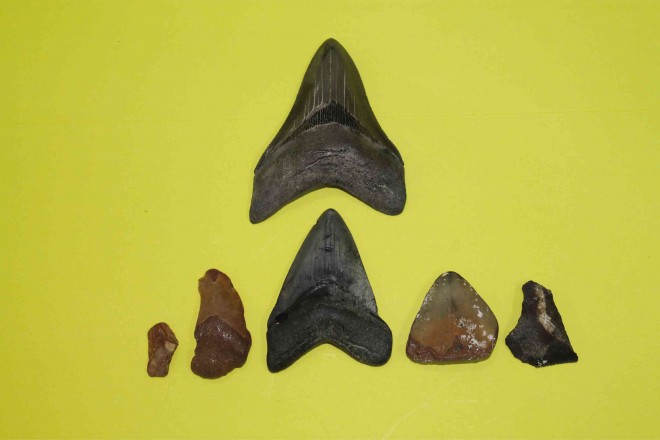
MEGALODON shark teeth fossils from the collection at the Marian School of Quezon City’s Museum of Rocks and Shells
During the Cenozoic Era, about 65 million years ago, a species of giant shark called the Megalodon ruled and dominated the ancient seas and oceans of the world.
It was the largest shark that ever lived, growing to a maximum length of 18.29 meters (60 feet) and attaining a staggering mass of 77 tons. It is regarded as the most formidable carnivore ever to have existed.
The mouth of this killing apparatus contained 276 serrated teeth ranging in size from 3 to 7 inches. The teeth were either shed naturally during the entire course of the shark’s life or lost during combat with a whale, which was a staple of the Megalodon’s diet.
Sheer size, great speed, brute force and very powerful jaws catapulted the Megalodon to the very top of the food chain. It took on whales, dolphins and porpoises, pinnipeds (seals), sea cows, giant sea turtles and even other sharks. It is one of the largest and most powerful predators in vertebrate history.
For all that, nothing physical or material remains of this mighty behemoth to serve as a reminder of the glory and grandeur it once was, except its teeth.
Because the Megalodon belonged to the family of sharks and rays, its skeleton was formed of cartilage rather than bone, resulting in poorly preserved fossil specimens.
Today, we know much about the Megalodon from studying the fossil remains of its teeth. In fact, the name Megalodon was derived from the Greek terms megas and odous which, put together, mean “big tooth.”
Good quality Megalodon shark teeth—triangular in shape, very solid in structure and with fine serration on two sides—are rare and expensive fossils much sought after by collectors, hobbyists and museums.
Seeing what is left of this once mighty alpha-predator of antediluvian waters—a wedge that measures no more than 180 millimeters (7 inches) in length—I cannot help but be reminded of my own mortality.
We can have it all while we are living on this earth, but we cannot take anything with us when we go. We are, as the dew of the night, vanishing like vampires before the onslaught of daylight.
All the things of this world are transient and transitory, volatile and evanescent, and we just cannot take them with us.
But, like the Megalodon, we can still leave something of what we were when we die. We can leave the relic, artifact or fossil of a good name and reputation behind us.
It is ever my desire to leave one single flower—one good deed—for which I will be remembered.
The writer is the academic supervisor at Marian School of Quezon City. E-mail sickbooks_togo@yahoo.com